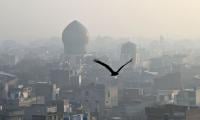The number of computersied national identity cards (CNICs) and B-forms having an address of Karachi is more than 19 million, said the Muttahida Qaumi Movement-Pakistan (MQM-P) in a statement issued on Thursday.
MQM-P Senator Faisal Subzwari had asked the National Database and Registration Authority (Nadra) to provide information about the number of CNICs and B-forms issued against addresses of Karachi.
Responding to the senator, the authority wrote, “Please be informed that total number of identities issued so far is 13.54 million. Furthermore, 41% of children below 18 years are also registered with NADRA.”
After this reply, the MQM-P claimed that the number of CNICs and B-forms issued by Nadra having an address of Karachi was more than 19 million.Taking to Twitter, Subzwari said that Nadra had disclosed that the number of registered children and ID cards made against Karachi addresses till March 27, 2023, was more than 19 million. He added that this gave an estimate of the population of Karachi as a large number of people who came from other parts of the country to the city even did not have an address of Karachi mentioned on their CNICs.
“Millions of people come to Karachi every year for employment whose identity card is not from here. Similarly, if you add millions of foreign residents, it is clear [that the population of Karachi is being understated],” the tweet read.
Meanwhile, addressing a press conference on Thursday, MQM-P Senior Deputy Convener Syed Mustafa Kamal said the party had succeeded in convincing the higher authorities of the country with evidence that the ongoing census in the urban areas of Sindh was fraud.
“As many as 32,000 buildings and 7,000 blocks have been identified where either the census teams had not reached or if any census team had reached there, their number inhabitants had been understated,” said Kamal.
He added that there were about 200 houses per census block and according to the results received so far, there were 860 blocks in Karachi where there was only one person per house. The Pakistan Bureau of Statistics had shown that the population of several census blocks is inclusive of 200 people only, the MQM-P leader said.
Referring to the K-Electric record, he said the number of residential meters was more than 3.4 million in Karachi and 25 per cent of the power consumers were those who had not installed KE meters but they were using electricity.
He said that in contrast to the KE meters, the results of the house census showed that the number of houses in the city was 2.9 million. “The people of Karachi and Sindh should be satisfied that this united, organised and dynamic MQM-Pakistan will not allow anyone to encroach on the rights of Karachi,” he said, adding that the MQM-P would not accept the false census data.
Kamal remarked that the MQM-P’s top trend ‘Census Hamari Red Line’ had woken the Jamaat-e-Islami from its sleep. The MQM-P leadership and workers were not only informing the government and the statistics agency about their reservations on the basis of evidence but they were also conveying public complaints about the census to the relevant institutions, he said.
He was of the view that the Jamaat-e-Islami (JI) and Pakistan Tehreek-e-Insaf (PTI) had betrayed Karachi by contesting the local government elections that were based on faulty delimitations.
He said that on the MQM-P’s demand, the Sindh government notified and added 53 union committees to Karachi to rectify the wrong delimitations. The MQM-P leader termed the PTI and JI anti-Karachi parties that had no stakes in the city.
The Pakistan Peoples Party (PPP) should realise that the urban population of Sindh is being deliberately understated. Muttahida Qaumi Movement-Pakistan (MQM-P) Senior Deputy Convener Dr Farooq Sattar said this while speaking as the chief guest at an Iftar dinner organised by the party’s Hyderabad chapter.
He said he was happy to be with people. He said such events showed that the political momentum of the MQM-P had been getting stronger. He added that unity could make any impossible thing possible.
He said that in terms of population, Karachi was the first and Hyderabad the third largest city in Pakistan. He lamented that the population of Peshawar and Quetta was not comparable to Hyderabad but now Hyderabad seemed to be in not even first 10 cities of the country in terms of population. Sindh paid taxes to the tune of Rs4,000 billion, but it was given Rs40 billion in charity, Dr Sattar said, adding that only Hyderabad should get Rs50 billion.
The MQM-P leader called for the PPP to take a firm stand against reduction in the official figures of the urban population of Sindh. He remarked that a large number of Burmese, Bengalis and Afghans also resided in Karachi, but the population growth rate of the city was being shown dismally low compared to Quetta and Peshawar.
He was of the view that whereas in the 2017 census, the urban population of Sindh had been reduced by 50 per cent than what it actually was, in the current census, the reduction of urban population of the province had been further increased to 66 per cent. Dr Sattar asked the PPP to support the MQM-P stance as Karachi and Hyderabad were two major source of revenue for it. He warned the PPP of public reaction in case it did not take the right stance.
An aerial view of Karachi city. — AFP/FileChait VasraandThe Canvas Gallery is hosting an art exhibition featuring...
This representational image shows students visiting a book stall. — PU website/FileA two-day book fair, the final...
This representational image shows the entrance of the University of Karachi. — APP/FileAs many as 16,506 students...
Representational image of a house on fire. — AFP/FileA fire broke out in a dye manufacturing factory in New...
Sindh Inspector General of Police Ghulam Nabi Memon chairs a meeting at CPO Headquarters in Karachi on September 19,...
The parliamentary secretary for science and technology, Government of Pakistan, Nikhat Shakeel Khan looks down in a...







